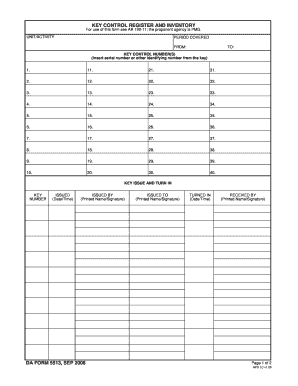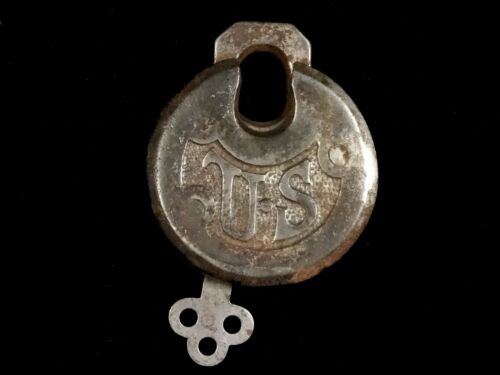Army Regulation Key Control
Introduction
In the Army, key control is an essential aspect of maintaining security and accountability. Proper key control procedures ensure that sensitive areas and equipment are secure and accessible only to authorized personnel. This article will provide an overview of the Army Regulation Key Control and its importance in maintaining a safe and secure environment. We will also explore the necessary steps to implement effective key control measures in your unit.
Why Army Regulation Key Control Matters

One of the fundamental reasons why key control is crucial in the Army is to prevent unauthorized access to sensitive areas and equipment. Imagine a scenario where a key to a restricted area falls into the wrong hands. It could jeopardize the safety and security of personnel, classified information, and valuable assets.
Army Regulation Key Control, as outlined in Army Regulation (AR) 190-51, provides the necessary guidance and procedures to ensure that keys are properly controlled and managed. This regulation establishes policies for the entire Army community and applies to all Active Duty, Reserve, and National Guard personnel.
Implementing Key Control Measures
To implement effective key control measures within your unit, it is crucial to follow the guidelines outlined in AR 190-51. Here are the key steps involved in establishing a robust key control system:
Step 1: Key Inventory
The first step in implementing key control measures is to conduct a thorough inventory of all keys within your unit. This includes documenting the purpose of each key, the areas or equipment it grants access to, and the individuals responsible for its custody.
By maintaining a comprehensive inventory, you can keep track of the number of keys, identify any missing keys promptly, and ensure that access is restricted to authorized personnel only.
Step 2: Key Issue and Return Procedures
Once you have established an accurate inventory, it is essential to develop a key issue and return procedure. This procedure outlines the process for assigning keys to personnel and ensuring their timely return when no longer needed.
Key issue and return records should be kept up to date, reflecting any changes in key assignments or custodians. Regular checks should be conducted to verify that issued keys are still necessary and are not being misused.
Step 3: Key Control Storage
Proper storage is critical to maintaining the security and integrity of keys. Keys should be stored in secure containers, such as lockable cabinets or key safes, when not in use.
Access to the key storage area should be limited to authorized personnel only. Additionally, it is essential to establish a signed key control register, which documents the details of each key's issuance and return.
Common Key Control Best Practices
While implementing key control measures, there are several best practices that can further enhance the security and effectiveness of your system:
1. Regular Audits and Inspections

Perform regular audits and inspections of key control procedures to identify any weaknesses or areas for improvement. This includes conducting spot checks on key storage areas and verifying the accuracy of key issue and return records.
2. Key Accountability
Hold individuals accountable for the keys assigned to them. Maintain a record of key custodians and regularly review their adherence to key control policies. Implement disciplinary measures for any violations or negligence in key management.
3. Training and Education
Ensure that all personnel involved in key control receive proper training and education. This includes understanding the importance of key control, the procedures to follow, and the consequences of non-compliance.
By equipping personnel with the necessary knowledge and skills, you can foster a culture of responsibility and accountability within your unit.
FAQs
Q1. How often should key control audits be conducted?
Key control audits should be conducted at least once every six months. However, more frequent audits are recommended to stay proactive and address any potential issues promptly.
Q2. Can keys be transferred between individuals without proper documentation?
No, transferring keys between individuals should always be properly documented to maintain accountability. The transfer should be recorded in the key control register and signed by both the transferring and receiving parties.
Q3. What should I do if a key is lost?
If a key is lost, it is crucial to immediately report the incident to the responsible authority. They will initiate the necessary actions, such as changing locks or reassigning access permissions, to mitigate any potential security breaches.
Conclusion
Army Regulation Key Control plays a vital role in maintaining the security and integrity of sensitive areas and equipment within the Army. By implementing effective key control measures, units can ensure that only authorized personnel have access to critical resources while minimizing the risk of unauthorized entry or misuse.
Remember, key control is not just a compliance requirement; it is a fundamental aspect of maintaining the safety and security of the entire Army community. By following the guidelines outlined in AR 190-51, units can establish a robust key control system that promotes accountability, prevents security breaches, and fosters a culture of responsibility.
Implementing proper key control measures is the responsibility of every Army personnel, and by doing so, you contribute to the overall strength and security of the Army.
KEY CONTROL REGISTER AND INVENTORY. DA FORM 5513, SEP 2006 - Army
 Image Source : www.signnow.com
Image Source : www.signnow.com key form army 5513 inventory da printable control log sign fillable template register templates sep 2006 blank fill sheet pdf
Da Form 5172-r - File Available
Cannabis Regulation And The Demons Of Absolute Control - Cannabis Digest
control key cannabis
Army: Army Key Control
 Image Source : armyteiato.blogspot.com
Image Source : armyteiato.blogspot.com memo sop
U.S. Army Regulation Padlock With Key WW1 -- Antique Price Guide
 Image Source : www.antiquesnavigator.com
Image Source : www.antiquesnavigator.com Sample Memorandum For Record Army - Financial Report
 Image Source : excelspreadsheetsgroup.com
Image Source : excelspreadsheetsgroup.com Army Joint Coordination - Memorandum: GAO Submission - 040716 - 16 July
memorandum army joint coordination pdf stationery submission gao july office unt library digital version also available edpm
Army: Army Key Control
 Image Source : armyteiato.blogspot.com
Image Source : armyteiato.blogspot.com U.s. army regulation padlock with key ww1 -- antique price guide. Key control register and inventory. da form 5513, sep 2006. Control key cannabis. Army: army key control. Army: army key control